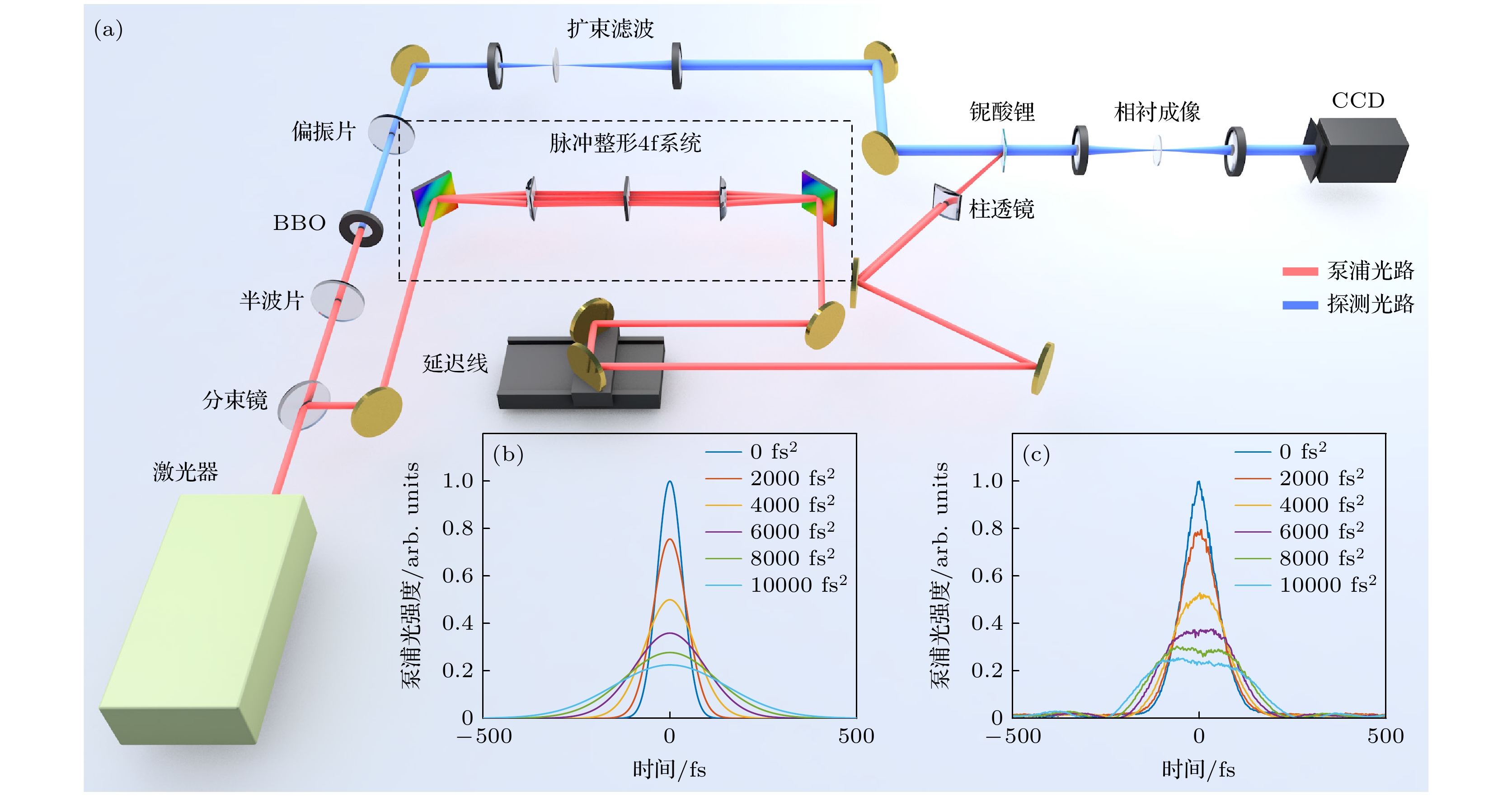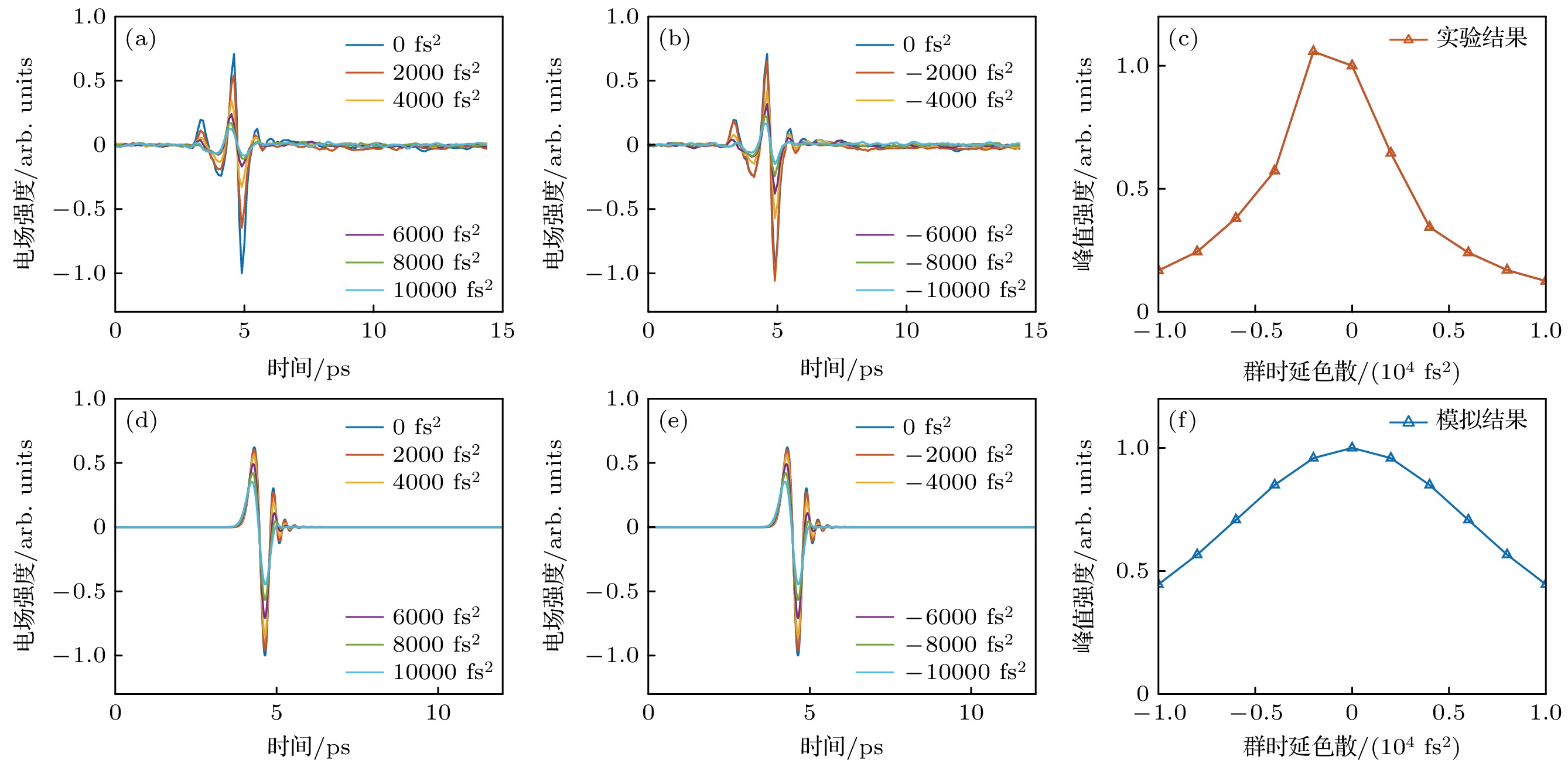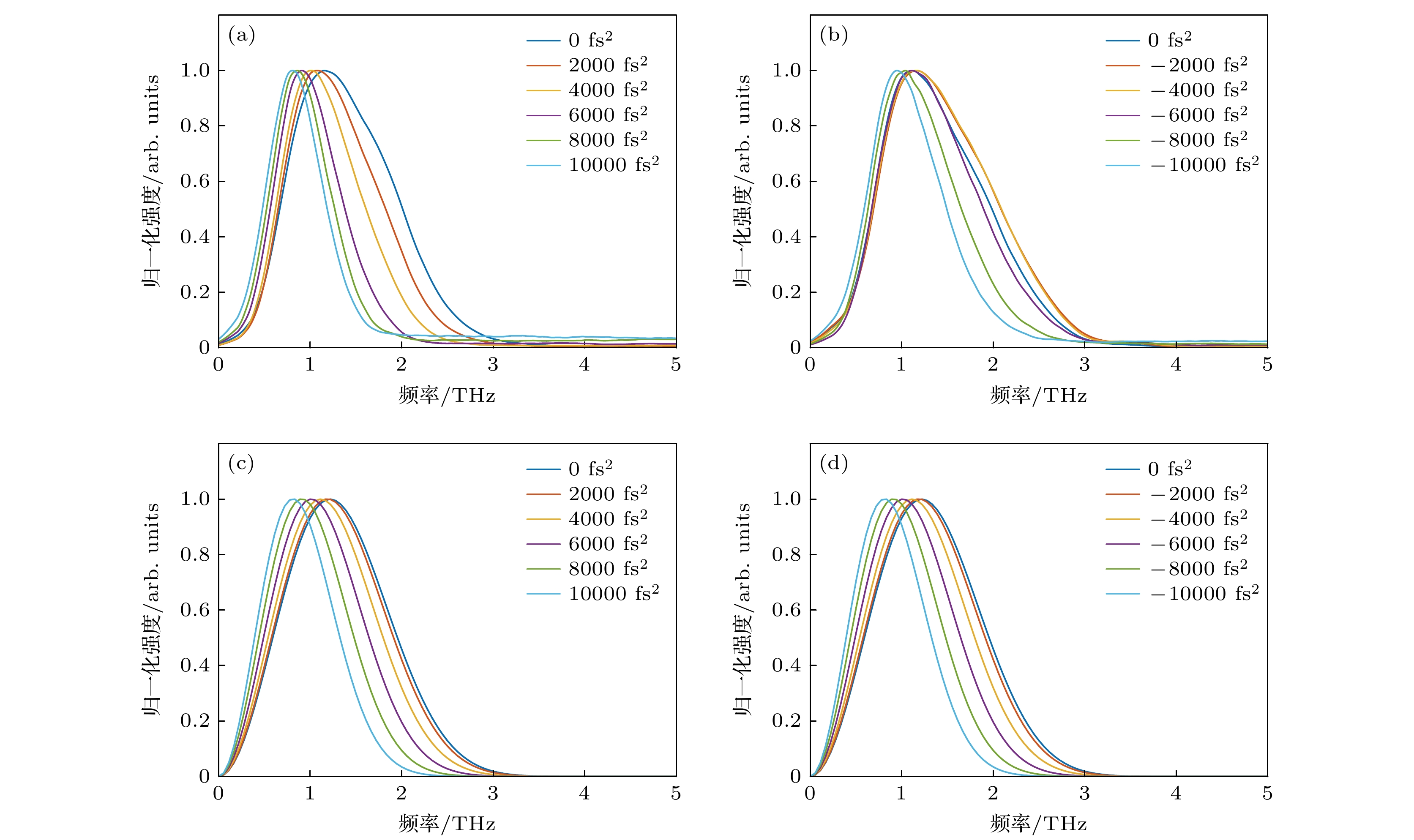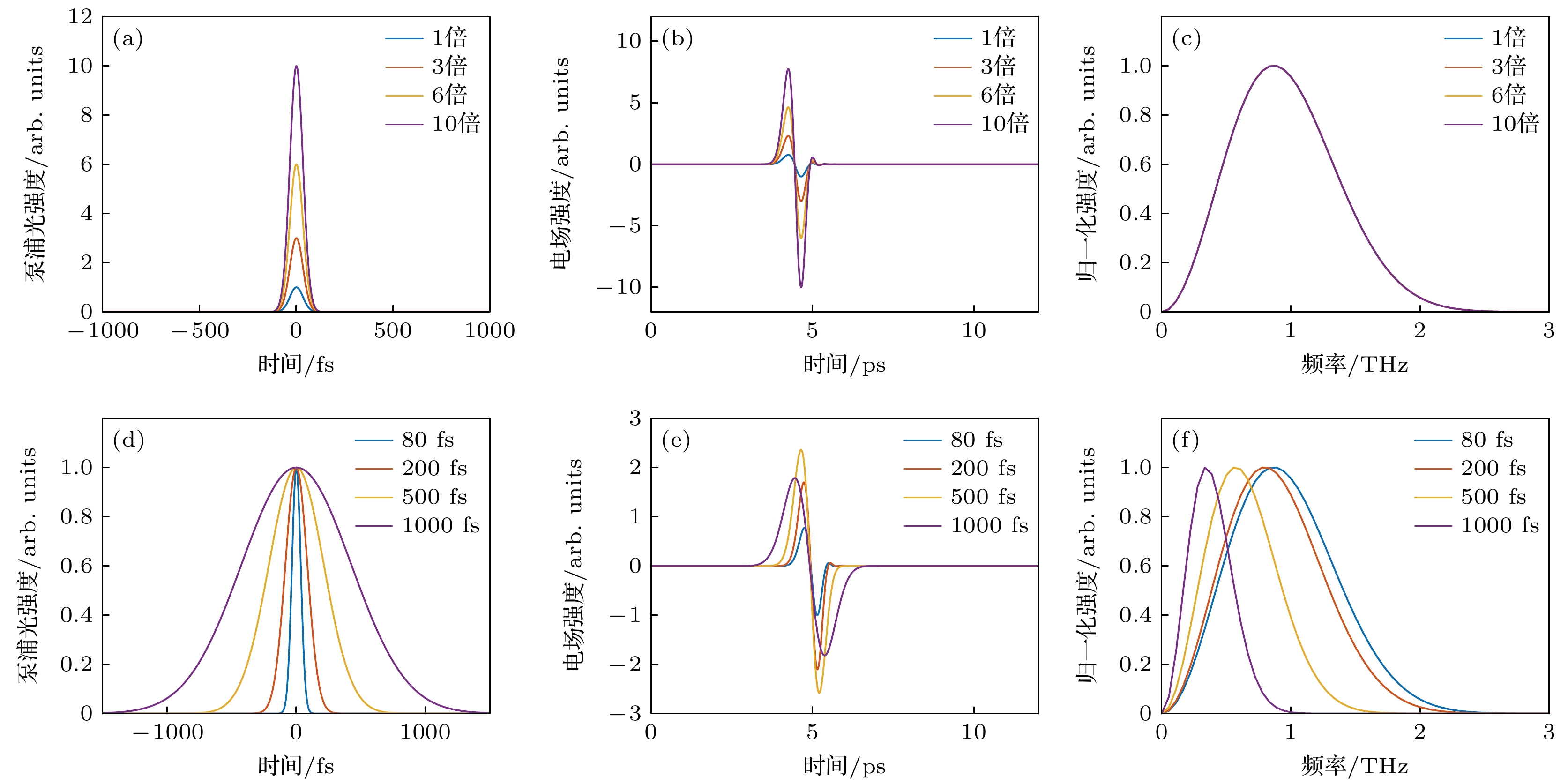-
Femtosecond laser excitation of nonlinear materials is one of the key technologies for generating terahertz waves at present. Due to its advantages such as ultrashort time resolution and ultrabroad frequency spectrum, the technology has been widely used to characterize, measure, sense and image terahertz waves. However, the methods of controlling terahertz waves through microstructures can only regulate their transmission process, and they will face obstacles such as design difficulty and complex processes, making it hard to be widely used in industry. In this work, by introducing a pulse-shaping system to change the time dispersion of femtosecond laser pulses, the interaction process between femtosecond laser and lithium niobate crystals can be directly regulated, therefore the terahertz generation process can be directly controlled. Taking the second-order time dispersion for example, the terahertz signals generated by pump light with different second-order time dispersion in lithium niobate is detected by using the pump-probe phase-contrast imaging system. Meanwhile, the generation process of terahertz waves is simulated using the impact stimulated Raman scattering model and Huang-Kun equation, demonstrating the feasibility of using femtosecond laser pulses to adjust the time dispersion of terahertz waves. The experimental and simulation results show that when the time dispersion of femtosecond laser causes the pulse width to increase, the time in which the lithium niobate lattice is subjected to the impact stimulated Raman scattering force is prolonged, and the macroscopic polarization of the lithium niobate lattice is correspondingly extended. On the one hand, the longer duration of polarization results in a wider terahertz signal in the time domain and a narrower one in the frequency domain. On the other hand, since the impact stimulated Raman scattering force is proportional to the pump light intensity and is in the same direction during the interaction time, when the Raman scattering force ends, the lattice reaches a maximum displacement. The longer Raman scattering force causes the lattice to move to one side for a longer time, and correspondingly, the subsequent vibration of one period takes a longer time, ultimately resulting in a lower center frequency. In addition, this work also points out that the modulation of terahertz signals by pump light pulse width may be affected by the thickness of the wafer, and the modulation effect on thinner media may be more obvious. This result is of great reference significance for the active regulation of on-chip terahertz sources based on lithium niobate crystals in the future.
-
Keywords:
- temporal dispersion /
- terahertz generation /
- on-chip integration
[1] Nagatsuma T, Ducournau G, Renaud C C 2016 Nat. Photonics 10 371
 Google Scholar
Google Scholar
[2] Shahriar B Y, Elezzabi A Y 2024 ACS Photonics 11 4733
 Google Scholar
Google Scholar
[3] Suzuki D, Oda S, Kawano Y 2016 Nat. Photonics 10 809
 Google Scholar
Google Scholar
[4] Lee G, Lee J, Park Q H, Seo M 2022 ACS Photonics 9 1500
 Google Scholar
Google Scholar
[5] Zhang X Q, Zhang X, Zhang Z C, Zhang T Y, Xu X X, Tang F, Yang J, Wang J K, Jiang H, Duan Z Y, Wei Y Y, Gong Y B, Zhang H, Li P N, Hu M 2024 Nano Lett. 24 15008
 Google Scholar
Google Scholar
[6] Srivastava Y K, Ako R T, Gupta M, Bhaskaran M, Sriram S, Singh R 2019 Appl. Phys. Lett. 115 151105
 Google Scholar
Google Scholar
[7] Basini M, Pancaldi M, Wehinger B, Udina M, Unikandanunni V, Tadano T, Hoffmann M C, Balatsky A V, Bonetti S 2024 Nature 628 534
 Google Scholar
Google Scholar
[8] Wu X J, Kong D Y, Hao S B, Zeng Y S, Yu X Q, Zhang B L, Dai M C, Liu S J, Wang J Q, Ren Z J, Chen S, Sang J H, Wang K, Zhang D D, Liu Z K, Gui J Y, Yang X J, Xu Y, Leng Y X, Li Y T, Song L W, Tian Y, Li R X 2023 Adv. Mater. 35 2208947
 Google Scholar
Google Scholar
[9] Burford N M, El-Shenawee M O 2017 Opt. Eng. 56 010901
 Google Scholar
Google Scholar
[10] Zhou X, Lu Y, Liu H B, Wu Q, Xu X T, Chen L, Li Z X, Wang R, Guo J, Xu J J 2023 Mater. Today Phys. 35 101102
 Google Scholar
Google Scholar
[11] Xu X T, Lu Y, Huang Y B, Zhou X, Ma R B, Xiong H, Li M L, Wu Q, Xu J J 2023 Opt. Express 31 44375
 Google Scholar
Google Scholar
[12] Xu X T, Huang Y B, Lu Y, Ma R B, Wu Q, Xu J J 2023 Chin. J. Lasers 50 1714004
 Google Scholar
Google Scholar
[13] Huang L, Tian D, Liao L Y, Qiu H S, Bai H, Wang Q, Pan F, Zhang C H, Jin B B, Song C 2025 Adv. Mater. 37 2402063
 Google Scholar
Google Scholar
[14] Liao G Q, Sun F Z, Lei H Y, Wang T Z, Wang D, Wei Y Y, Liu F, Wang X, Li Y T, Zhang J 2024 Phys. Rev. Lett. 132 155001
 Google Scholar
Google Scholar
[15] Zhang S J, Zhou W M, Yin Y, Zou D B, Zhao N, Xie D, Zhuo H B 2023 Chin. Phys. B 32 035201
 Google Scholar
Google Scholar
[16] Cheng H Y, Ma Q R, Xu H R, Zhang H P, Jin Z M, He W, Peng Y 2024 Acta Phys. Sin. 73 167801 [程宏阳, 马倩茹, 徐浩然, 张慧萍, 金钻明, 何为, 彭滟 2024 物理学报 73 167801]
 Google Scholar
Google Scholar
Cheng H Y, Ma Q R, Xu H R, Zhang H P, Jin Z M, He W, Peng Y 2024 Acta Phys. Sin. 73 167801
 Google Scholar
Google Scholar
[17] Xiong H, Lu Y, Wu Q, Li Z X, Qi J W, Xu X T, Ma R B, Xu J J 2021 ACS Photonics 8 2737
 Google Scholar
Google Scholar
[18] Huang Y B, Lu Y, Li W, Xu X T, Jiang X D, Ma R B, Chen L, Ruan N J, Wu Q, Xu J 2024 Light: Sci. Appl. 13 212
 Google Scholar
Google Scholar
[19] Lu Y, Huang Y B, Cheng J K, Ma R B, Xu X T, Zang Y J, Wu Q, Xu J J 2024 Nanophotonics 13 3279
 Google Scholar
Google Scholar
[20] Liu W C, Zhou X W, Zou S C, Hu Z G, Shen Y, Cai M Q, Lin D D, Zhou J, Deng X H, Guo T J, Lei J T 2023 Nanophotonics 12 1177
 Google Scholar
Google Scholar
[21] Xu J J, Liao D G, Gupta M, Zhu Y M, Zhuang S L, Singh R, Chen L 2021 Adv. Opt. Mater. 9 2100024
 Google Scholar
Google Scholar
[22] Liu B W, Peng Y, Jin Z M, Wu X, Gu H Y, Wei D S, Zhu Y M, Zhuang S L 2023 Chem. Eng. J. 462 142347
 Google Scholar
Google Scholar
[23] Huang L H, Cao H Y, Chen L, Ma Y, Yang Y H, Liu X Y, Wang W Q, Zhu Y M, Zhuang S L 2024 Talanta 269 125481
 Google Scholar
Google Scholar
[24] Kosloff R, Hammerich A D, Tannor D 1992 Phys. Rev. Lett. 69 2172
 Google Scholar
Google Scholar
[25] Chesnoy J, Mokhtari A 1988 Phys. Rev. A 38 3566
 Google Scholar
Google Scholar
[26] Huang K 1951 Nature 167 779
 Google Scholar
Google Scholar
[27] Huang K 1951 Proc. R. Soc. Lon. Ser. A 208 352
 Google Scholar
Google Scholar
[28] Wu Q, Lu Y, Ma R B, Xu X T, Huang Y B, Xu J J 2024 Laser Optoelectron. Prog. 61 0119001
 Google Scholar
Google Scholar
[29] Wu Q, Werley C A, Lin K H, Dorn A, Bawendi M G, Nelson K A 2009 Opt. Express 17 9219
 Google Scholar
Google Scholar
[30] Weiner A M 2000 Rev. Sci. Instrum. 71 1929
 Google Scholar
Google Scholar
[31] Parize G, Natile M, Guichard F, Comby A, Hanna M, Georges P 2025 Appl. Phys. Lett. 126 101105
 Google Scholar
Google Scholar
-
图 1 实验系统构成 (a)泵浦探测光路; (b)模拟中不同群时延色散的泵浦光的强度变化; (c)实验中不同群时延色散的泵浦光的强度变化
Figure 1. Composition of the experimental system: (a) Pump-probe optical path; (b) intensity variation of pump light with different group delay dispersion in the simulation; (c) intensity variation of pump light with different group delay dispersion in the experiment.
图 2 泵浦光功率一致时的时域信号 (a)—(c)实验中不同色散泵浦光产生的THz信号及其相对峰值强度变化; (d)—(f)模拟中不同色散泵浦光产生的THz信号及其相对峰值强度变化
Figure 2. Time domain signal when the pump light power is consistent: (a)–(c) THz signals generated by different dispersion pump lights and their relative peak intensity changes in the experiment; (d)–(f) THz signals generated by pump lights with different dispersions and their relative peak intensity changes in the simulation.
图 3 泵浦光功率一致时的频域信号 (a), (b)实验中不同色散泵浦光产生的THz信号; (c), (d)模拟中不同色散泵浦光产生的THz信号
Figure 3. Frequency domain signal when the pump light power is consistent: (a), (b) THz signals generated by pump lights with different dispersion in the experiment; (c), (d) THz signals generated by pump lights with different dispersion in the simulation.
图 4 高斯脉冲模拟泵浦产生THz波 (a)—(c)脉宽相同、峰值强度不同的泵浦光及其产生的THz信号; (d)—(f)脉宽不同、峰值强度相同的泵浦光及其产生的THz信号
Figure 4. Gaussian pulse simulates pumping to generate THz waves: (a)–(c) THz signals generated by pump lights with the same pulse width but different intensities; (d)–(f) THz signals generated by pump lights with different pulse widths but the same intensity
-
[1] Nagatsuma T, Ducournau G, Renaud C C 2016 Nat. Photonics 10 371
 Google Scholar
Google Scholar
[2] Shahriar B Y, Elezzabi A Y 2024 ACS Photonics 11 4733
 Google Scholar
Google Scholar
[3] Suzuki D, Oda S, Kawano Y 2016 Nat. Photonics 10 809
 Google Scholar
Google Scholar
[4] Lee G, Lee J, Park Q H, Seo M 2022 ACS Photonics 9 1500
 Google Scholar
Google Scholar
[5] Zhang X Q, Zhang X, Zhang Z C, Zhang T Y, Xu X X, Tang F, Yang J, Wang J K, Jiang H, Duan Z Y, Wei Y Y, Gong Y B, Zhang H, Li P N, Hu M 2024 Nano Lett. 24 15008
 Google Scholar
Google Scholar
[6] Srivastava Y K, Ako R T, Gupta M, Bhaskaran M, Sriram S, Singh R 2019 Appl. Phys. Lett. 115 151105
 Google Scholar
Google Scholar
[7] Basini M, Pancaldi M, Wehinger B, Udina M, Unikandanunni V, Tadano T, Hoffmann M C, Balatsky A V, Bonetti S 2024 Nature 628 534
 Google Scholar
Google Scholar
[8] Wu X J, Kong D Y, Hao S B, Zeng Y S, Yu X Q, Zhang B L, Dai M C, Liu S J, Wang J Q, Ren Z J, Chen S, Sang J H, Wang K, Zhang D D, Liu Z K, Gui J Y, Yang X J, Xu Y, Leng Y X, Li Y T, Song L W, Tian Y, Li R X 2023 Adv. Mater. 35 2208947
 Google Scholar
Google Scholar
[9] Burford N M, El-Shenawee M O 2017 Opt. Eng. 56 010901
 Google Scholar
Google Scholar
[10] Zhou X, Lu Y, Liu H B, Wu Q, Xu X T, Chen L, Li Z X, Wang R, Guo J, Xu J J 2023 Mater. Today Phys. 35 101102
 Google Scholar
Google Scholar
[11] Xu X T, Lu Y, Huang Y B, Zhou X, Ma R B, Xiong H, Li M L, Wu Q, Xu J J 2023 Opt. Express 31 44375
 Google Scholar
Google Scholar
[12] Xu X T, Huang Y B, Lu Y, Ma R B, Wu Q, Xu J J 2023 Chin. J. Lasers 50 1714004
 Google Scholar
Google Scholar
[13] Huang L, Tian D, Liao L Y, Qiu H S, Bai H, Wang Q, Pan F, Zhang C H, Jin B B, Song C 2025 Adv. Mater. 37 2402063
 Google Scholar
Google Scholar
[14] Liao G Q, Sun F Z, Lei H Y, Wang T Z, Wang D, Wei Y Y, Liu F, Wang X, Li Y T, Zhang J 2024 Phys. Rev. Lett. 132 155001
 Google Scholar
Google Scholar
[15] Zhang S J, Zhou W M, Yin Y, Zou D B, Zhao N, Xie D, Zhuo H B 2023 Chin. Phys. B 32 035201
 Google Scholar
Google Scholar
[16] Cheng H Y, Ma Q R, Xu H R, Zhang H P, Jin Z M, He W, Peng Y 2024 Acta Phys. Sin. 73 167801 [程宏阳, 马倩茹, 徐浩然, 张慧萍, 金钻明, 何为, 彭滟 2024 物理学报 73 167801]
 Google Scholar
Google Scholar
Cheng H Y, Ma Q R, Xu H R, Zhang H P, Jin Z M, He W, Peng Y 2024 Acta Phys. Sin. 73 167801
 Google Scholar
Google Scholar
[17] Xiong H, Lu Y, Wu Q, Li Z X, Qi J W, Xu X T, Ma R B, Xu J J 2021 ACS Photonics 8 2737
 Google Scholar
Google Scholar
[18] Huang Y B, Lu Y, Li W, Xu X T, Jiang X D, Ma R B, Chen L, Ruan N J, Wu Q, Xu J 2024 Light: Sci. Appl. 13 212
 Google Scholar
Google Scholar
[19] Lu Y, Huang Y B, Cheng J K, Ma R B, Xu X T, Zang Y J, Wu Q, Xu J J 2024 Nanophotonics 13 3279
 Google Scholar
Google Scholar
[20] Liu W C, Zhou X W, Zou S C, Hu Z G, Shen Y, Cai M Q, Lin D D, Zhou J, Deng X H, Guo T J, Lei J T 2023 Nanophotonics 12 1177
 Google Scholar
Google Scholar
[21] Xu J J, Liao D G, Gupta M, Zhu Y M, Zhuang S L, Singh R, Chen L 2021 Adv. Opt. Mater. 9 2100024
 Google Scholar
Google Scholar
[22] Liu B W, Peng Y, Jin Z M, Wu X, Gu H Y, Wei D S, Zhu Y M, Zhuang S L 2023 Chem. Eng. J. 462 142347
 Google Scholar
Google Scholar
[23] Huang L H, Cao H Y, Chen L, Ma Y, Yang Y H, Liu X Y, Wang W Q, Zhu Y M, Zhuang S L 2024 Talanta 269 125481
 Google Scholar
Google Scholar
[24] Kosloff R, Hammerich A D, Tannor D 1992 Phys. Rev. Lett. 69 2172
 Google Scholar
Google Scholar
[25] Chesnoy J, Mokhtari A 1988 Phys. Rev. A 38 3566
 Google Scholar
Google Scholar
[26] Huang K 1951 Nature 167 779
 Google Scholar
Google Scholar
[27] Huang K 1951 Proc. R. Soc. Lon. Ser. A 208 352
 Google Scholar
Google Scholar
[28] Wu Q, Lu Y, Ma R B, Xu X T, Huang Y B, Xu J J 2024 Laser Optoelectron. Prog. 61 0119001
 Google Scholar
Google Scholar
[29] Wu Q, Werley C A, Lin K H, Dorn A, Bawendi M G, Nelson K A 2009 Opt. Express 17 9219
 Google Scholar
Google Scholar
[30] Weiner A M 2000 Rev. Sci. Instrum. 71 1929
 Google Scholar
Google Scholar
[31] Parize G, Natile M, Guichard F, Comby A, Hanna M, Georges P 2025 Appl. Phys. Lett. 126 101105
 Google Scholar
Google Scholar
Catalog
Metrics
- Abstract views: 4597
- PDF Downloads: 84
- Cited By: 0















 DownLoad:
DownLoad:



